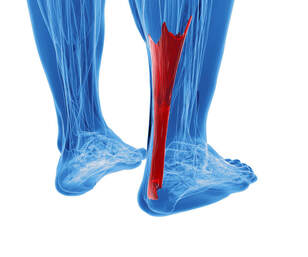|
Tricia Hayton, Registered Physiotherapist Since Durant’s recent quick exit from the NBA series, calf injuries have been a hot topic of conversation. What was the initial injury? How did it change so drastically? First, a little anatomy lesson is needed to understand what happened. The calf is made up of two or three muscles. The deepest is a very small muscle called the plantaris. About 20% to 30% of the population do not even have this muscle, however they do not have any change in function or athletic ability. More critical to function, are the soleus and gastrocnemius. These muscles are large, powerful muscles that propel the body up (as in jumping) and forward (as in running). They blend together to form a strong tendon called the Achilles tendon. The initial injury was called a calf strain. This is a small tear or fray of the muscle of the calf. Although technically it can occur anywhere in the gastrocsoleus complex, it most commonly occurs where the head of the gastrocnemius gradually blends into a tendon. If you were to look at a muscular calf, the surface muscle, the gastric, is made up of two circular heads that come together about two-thirds of the way down the shin bone. Where these circular heads come together is where the tendon starts. This is the most common location for a strain. Medically, we grade strains as first, second, or third. A first-degree strain is when the muscle pulls and stretches beyond what is comfortable, but there is no tear of the fibers. A second-degree strain is where the stretch tears some of the muscle fibers, but the muscle is still securely connected to the bones at each end. A third-degree tear is when the muscle tears in two. The injury suffered by Durant during the finals was an Achilles tear or rupture. This is very similar to a Grade three strain. The tendon has been torn in two and is no longer connecting the two bones. This means that the muscle is no longer able to generate any power. Thus, Durant can no longer run or jump. Surgery or serial casting is needed to repair this injury. Each case is analyzed by an orthopedic surgeon and the most appropriate way of completing the repair is decided. Factors considered include age, athletic demands, time span until return to sport, and severity of tear. Complete rehabilitation of this injury typically takes 6 months to return to sport, although we all know that a professional player may bend this rule slightly. I think the critical lesson for those of us in sports medicine is that we need to make sure that we are not encouraging our athletes to return to sport too early. Proper strengthening and healing is critical because although the risk of reinjury may be small, the consequence is huge.
0 Comments
Your comment will be posted after it is approved.
Leave a Reply. |
Physio Sport Med
Serving all of Oakville in the Uptown / Dundas-Trafalgar Core. Archives
May 2025
Categories |
- Info
- Book Now
-
Team
-
How We Treat
- Sport Medicine Consultation
- Manual - Exercise Physio
- Sport Physiotherapy
- Tissue Injections
- Acupuncture
- Vestibular Physiotherapy
- Osteopathy
- Chiropractic Care
- Concussion Program
- Shockwave Therapy
- Female Pelvic Health
- Male Pelvic Health
- Registered Massage Therapy
- Nutrition Consultation
- On-Field Therapy Coverage
- Custom Orthotics
-
What We Treat
- Sports Injuries
- Low Back Pain
- Osteoarthritis
- Motor Vehicle Accident
- Sprains
- Muscle Strains
- Concussion
- Rotator Cuff
- Tendonitis
- Neck Pain and Headaches
- Hip Pain
- Shoulder Pain
- Elbow, Wrist and Hand Pain
- Foot and Ankle Pain
- Post Surgical Rehabilitation
- Gait and Balance Disorders
- Knee Injuries
- Pelvic Floor Conditions
- Blog


 RSS Feed
RSS Feed